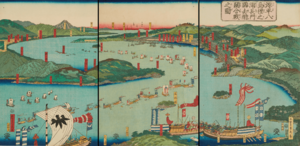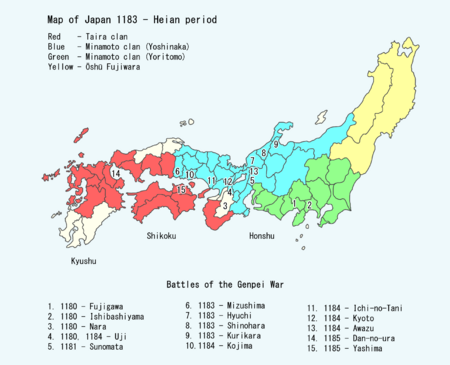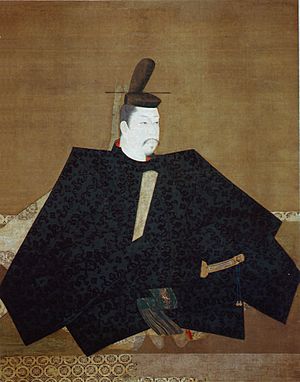Genpei War facts for kids
Quick facts for kids Genpei War (Jishō–Juei War) |
||||||||
|---|---|---|---|---|---|---|---|---|
| Part of Minamoto–Taira clan disputes of late Heian period | ||||||||
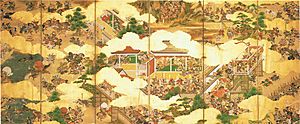 Scene of the Genpei War |
||||||||
|
||||||||
| Belligerents | ||||||||
|
|
||||||||
| Commanders and leaders | ||||||||
|
|
|||||||
The Genpei War (also called Jishō–Juei War) was a big civil war in Japan. It happened between 1180 and 1185. Two powerful families, the Taira and the Minamoto, fought for control of the country.
The war began after the Taira family took over the government in 1179. They removed their rivals from important jobs. The Minamoto family then called for people to fight against the Taira in 1180. The first big battle was near Kyoto, starting a five-year war. The Minamoto family won the final battle at sea, called the Battle of Dan-no-ura. This victory led to the Taira family losing all their power.
After the war, Minamoto no Yoritomo became the first Shōgun in 1192. A shogun was a military ruler who governed Japan. Yoritomo set up his government in the city of Kamakura. The name "Genpei" comes from the Japanese names for Minamoto (Gen) and Taira (Hei).
Contents
Why the War Started
The Genpei War was the final part of a long fight between the Taira and Minamoto families. They both wanted to control the Imperial court and, through it, all of Japan. In earlier rebellions, like the Hōgen Rebellion and the Heiji Rebellion, the Minamoto tried to take back power but failed.
In 1180, Taira no Kiyomori put his grandson, Emperor Antoku, on the throne. Emperor Antoku was only two years old. Emperor Go-Shirakawa's son, Prince Mochihito, felt he should have been the emperor. So, with help from Minamoto no Yorimasa, he asked the Minamoto family and Buddhist temples to fight the Taira. However, this plan failed, and both Yorimasa and Mochihito died.
In June 1180, Kiyomori moved the emperor's home to a new city called Fukuhara-kyō. He wanted to keep the royal family very close to him.
War Begins: Early Battles
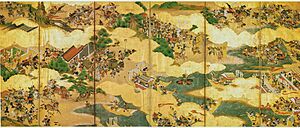

Taira no Kiyomori's actions made the Minamoto family hate the Taira even more. So, Minamoto no Yorimasa and Prince Mochihito called for a fight. Kiyomori ordered Mochihito's arrest. Mochihito tried to find safety at a temple called Mii-dera, but it wasn't safe enough.
He was chased by Taira soldiers to the Byōdō-in temple, near Kyoto. The war officially began with a battle at the bridge over the Uji River. Yorimasa died inside the Byōdō-in. Mochihito was captured and killed soon after.
After this, Minamoto no Yoritomo became the new leader of the Minamoto clan. He traveled around Japan to find allies. He was defeated by the Taira at the battle of Ishibashiyama. But he managed to reach other provinces where friendly families, like the Takeda, helped him fight off the Taira army. Meanwhile, Kiyomori attacked Nara and burned much of the city. He was angry at the monks who had helped Mochihito.
Fighting continued in 1181. Minamoto no Yukiie was defeated by Taira no Shigehira at the Battle of Sunomatagawa. However, the Taira could not follow up on their win.
Taira no Kiyomori died from an illness in the spring of 1181. Around the same time, Japan faced a severe famine. The Taira tried to attack Minamoto no Yoshinaka, a cousin of Yoritomo, but they failed. The war then paused for almost two years, starting again in the spring of 1183.
War Turns Around
In 1183, the Taira suffered a huge loss at the Battle of Kurikara. A few months later, they were trapped in Kyoto. Yoshinaka was coming from the north, and Yukiie from the east. Both Minamoto leaders had easily reached the capital. The Taira were forced to leave the city.
Taira no Munemori, who led the Taira clan after his father Kiyomori died, took his army, the young Emperor Antoku, and the Imperial treasures (called the Imperial regalia) to the west. The retired emperor Go-Shirakawa joined Yoshinaka. Go-Shirakawa then ordered Yoshinaka to destroy Munemori and his army.
In 1183, Yoshinaka tried to take control of the Minamoto clan by planning to attack Yoritomo. At the same time, he chased the Taira westward. The Taira set up a temporary court in Dazaifu on Kyūshū island. But they were soon forced out by local rebellions started by Go-Shirakawa. They then moved their court to Yashima. The Taira managed to defeat an attack by Yoshinaka's forces at the Battle of Mizushima.
Yoshinaka then planned with Yukiie to take over Kyoto and the Emperor. He even thought about setting up a new court in the north. But Yukiie told the Emperor about these plans, and the Emperor told Yoritomo. Feeling betrayed, Yoshinaka took control of Kyoto. In early 1184, he burned down the Hōjūjidono palace and took the Emperor captive.
Minamoto no Yoshitsune, Yoritomo's younger brother, arrived soon after with his brother Noriyori and a large army. They drove Yoshinaka out of the city. After fighting his cousins at the bridge over the Uji River again, Yoshinaka made his last stand at Awazu. He was defeated and killed by Yoshitsune while trying to escape.
End of the War
As the Minamoto armies left Kyoto, the Taira gathered their forces in their home territory around the Inland Sea. The Emperor sent messages offering a truce if they surrendered. This was a trick, as the Minamoto and the Emperor planned to attack anyway. The trick gave the Emperor a chance to get back the Imperial treasures and confuse the Taira leaders.
The Minamoto army, led by Yoshitsune and Noriyori, made their first big attack at Ichi-no-Tani. This was a main Taira camp on Honshū island. Yoshitsune and Noriyori attacked the camp from two sides. The Taira who were not killed or captured escaped to Yashima. The Minamoto were not ready to attack Shikoku island yet. So, there was a six-month break while they prepared. Even though they were retreating, the Taira had an advantage. They were in their own lands and were much better at fighting at sea.
Almost a year after the battle of Ichi-no-Tani, the main Taira force at Yashima was attacked. The Taira saw Yoshitsune's campfires behind them. They did not expect an attack from land and quickly got on their ships. But this was a clever trick by the Minamoto. The Taira's temporary palace fell, and many escaped with the Imperial treasures and Emperor Antoku.
The Genpei War ended one month later with the battle of Dan-no-ura. This was one of the most famous and important battles in Japanese history. The Minamoto fought the Taira fleet in the Straits of Shimonoseki. The ocean tides played a big role. At first, the tides helped the Taira, who were better sailors. But then the tides changed, helping the Minamoto. A Taira general named Taguchi also switched sides during the battle, which greatly helped the Minamoto. Many Taira nobles died, along with Emperor Antoku and Kiyomori's wife.
What Happened After the War
The Taira armies' defeat meant they no longer controlled the capital city. In December 1185, Emperor Go-Shirakawa gave Yoritomo the power to collect taxes and appoint officials in all provinces. Finally, in 1192, after Go-Shirakawa died, Yoritomo was given the title of Sei-i Tai Shōgun. This was the start of a feudal system in Japan. Real power was now in Kamakura. However, Kyoto remained the official capital for ceremonies.
The end of the Genpei War and the start of the Kamakura shogunate meant that the warrior class, called samurai, became very powerful. The emperor's power slowly decreased. He became mostly a symbolic leader, without real political or military power. This lasted for over 650 years until the Meiji Restoration.
Also, this war made red and white Japan's national colors. These were the colors of the Taira and Minamoto flags. Today, you can see these colors on the flag of Japan. They are also used in sumo wrestling and other traditional Japanese activities.
Key Battles of the War
- 1180 First Battle of Uji – Monks fought alongside Minamoto no Yorimasa.
- 1180 Siege of Nara – The Taira burned temples to cut off supplies to their enemies.
- 1180 Battle of Ishibashiyama – Minamoto no Yoritomo's first battle, which the Taira won.
- 1180 Battle of Fujikawa – The Taira mistook birds for a Minamoto attack and retreated.
- 1181 Battle of Sunomatagawa – The Taira stopped a night attack but then retreated.
- 1181 Battle of Yahagigawa – The Minamoto tried to make a stand while retreating.
- 1183 Siege of Hiuchi – The Taira attacked a Minamoto fortress.
- 1183 Battle of Kurikara – The war turned in favor of the Minamoto.
- 1183 Battle of Shinohara – Yoshinaka chased the Taira after Kurikara.
- 1183 Battle of Mizushima – The Taira stopped a Minamoto force heading for Yashima.
- 1183 Siege of Fukuryūji – The Minamoto attacked a Taira fortress.
- 1183 Battle of Muroyama – Minamoto no Yukiie tried but failed to make up for the loss at Mizushima.
- 1184 Siege of Hōjūjidono – Yoshinaka burned a palace and took Emperor Go-Shirakawa.
- 1184 Second Battle of Uji – Yoshitsune and Noriyori chased Yoshinaka out of the capital.
- 1184 Battle of Awazu – Minamoto no Yoshinaka was defeated and killed.
- 1184 Battle of Ichi-no-Tani – Minamoto no Yoshitsune attacked and drove the Taira from a main fortress.
- 1184 Battle of Kojima – Taira escaping Ichi-no-Tani were attacked by Minamoto no Noriyori.
- 1185 Battle of Yashima – The Minamoto attacked the Taira's fortress off Shikoku.
- 1185 Battle of Dan-no-ura – Minamoto no Yoshitsune won a decisive naval battle, ending the war.
Important People in the War
Minamoto Clan (also called "Genji")
The Minamoto were one of four big families that were important in Japan during the Heian period (794–1185). They were almost wiped out by the Taira in the Heiji Rebellion of 1160. Minamoto no Yoshitomo was the clan head then. After he was defeated by Taira no Kiyomori, two of his sons were killed. The third son, Minamoto no Yoritomo, was sent away. After Prince Mochihito and Minamoto no Yorimasa called for war in 1180, the clan came back to power. The Genpei War ended with the Minamoto clan defeating the Taira and taking control of Japan.
- Minamoto no Noriyori (源範頼) – A general and Yoritomo's younger brother.
- Minamoto no Yorimasa (源頼政) – The clan head at the start of the war.
- Minamoto no Yoritomo (源頼朝) – Became the clan head after Yorimasa died.
- Minamoto no Yoshitsune (源義経) – Yoritomo's younger brother and a main general.
- Minamoto no Yukiie (源行家) – A general and Yoritomo's uncle.
- Allies and Supporters:
- Emperor Go-Shirakawa (後白河) – The retired emperor.
- Prince Mochihito (以仁王) – An Imperial Prince.
- Benkei (弁慶) – A warrior monk and Yoshitsune's ally.
- Hōjō Tokimasa (北条 時政) – Head of the Hōjō clan and Yoritomo's father-in-law.
- Kajiwara Kagetoki (梶原 景時) – An ally of Yoshitsune, but secretly a spy for Yoritomo.
- Kumagai Naozane (熊谷 直実) – A warrior who served Yoritomo.
- Sasaki Moritsuna (佐々木 盛綱) – A warrior who served Noriyori.
- Taguchi Shigeyoshi (田口 重能) – A Taira general who switched to the Minamoto side at the Battle of Dan-no-ura.
- Nasu no Yoichi (那須与一) – A famous archer and Minamoto ally.
- Yada Yoshiyasu (矢田 義康) – A warrior who served Yoshinaka.
- The sōhei (warrior-monks) from Mii-dera and other temples.
- Tsutsui Jōmyō Meishū (筒井 浄妙 明秀) – Fought bravely on the Uji bridge.
- Gochi-in no Tajima (五智院 但馬) – Known for deflecting arrows with his naginata.
- Ichirai Hoshi (一来 法師) – Led the Mii-dera monks into battle.
- Supporters of Minamoto no Yoshinaka (源義仲):
- Imai Kanehira (今井 兼平) – Joined Yoshinaka in his escape.
Taira Clan (also called "Heike")
The Taira clan was another of the four big families that were important in Japan. After almost destroying their rival, the Minamoto, in the Heiji Rebellion of 1160, Taira no Kiyomori, the clan head, started the Genpei War when his power was at its peak. However, the war ended with the Taira clan being destroyed.
- Taira no Atsumori (平敦盛) – A young samurai killed by Kumagai Naozane, who became famous for his sad death.
- Taira no Kiyomori (平清盛) – The clan head at the start of the war.
- Taira no Koremori (平維盛) – Kiyomori's grandson.
- Taira no Munemori (平宗盛) – Kiyomori's son and heir; led the clan for most of the war.
- Taira no Noritsune (平教経) – A Taira samurai.
- Taira no Shigehira (平重衡) – A general and Kiyomori's son.
- Taira no Tadanori (平忠度) – A general and Kiyomori's brother.
- Taira no Tokiko (平時子) – Kiyomori's wife, who took her own life at the Battle of Dan-no-ura.
- Taira no Tomomori (平知盛) – A general and Kiyomori's son.
- Taira no Yukimori (平行盛) – A general who led Taira forces at the Battle of Kojima.
- Taira no Kagekiyo (平景清) – A Taira samurai.
- Allies and Supporters:
- Emperor Antoku (安徳) – The Emperor of Japan and Kiyomori's grandson.
- Ōba Kagechika (大庭景親) – A warrior who served the Taira.
- Saitō Sanemori (斎藤実盛) – A former Minamoto warrior who switched sides to the Taira.
- Senoo Kaneyasu (妹尾兼康) – A Taira warrior who commanded at the Fukuryūji fortress.
- Taguchi Shigeyoshi (田口 重能) – A Taira general who switched to the Minamoto side at the Battle of Dan-no-ura.
- The sōhei (warrior-monks) of Enryaku-ji (延暦寺) – They were rivals with the Mii-dera monks, who were allied with the Minamoto.
In Books and Stories
Many stories and artworks show this conflict. The Tale of the Heike is the most famous book about it. Many kabuki and bunraku plays also tell parts of the war. Ichinotani Futaba Gunki is one of the most famous plays.
The novel Shike by Robert Shea tells a fictional story of the wars. It's seen through the eyes of two main characters. The names of the clans are changed to "Muratomo" and "Takashi."
Another fictional story about the war is in "Civil War," the ninth book of Osamu Tezuka's Phoenix comic series.
The Genpei War is also the setting for much of Katherine Patterson's young adult novel, Of Nightingales That Weep.
See also
- Military history of Japan
- Sanemori (Noh play)
- Sukiyaki Western Django, a film inspired by the events





